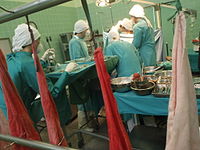
Photo from wikipedia
Increasing Transplant Access As treatments for certain types of cancer, as well as cancer prognoses, have improved, transplant centers have encountered more potential transplant recipients with a prior malignancy. This… Click to show full abstract
Increasing Transplant Access As treatments for certain types of cancer, as well as cancer prognoses, have improved, transplant centers have encountered more potential transplant recipients with a prior malignancy. This new reality, along with the wide range of responses from transplant centers, is what prompted development of a consensus on how to achieve a more uniform response to cancer among transplant centers. The ideal outcome is expansion. “We’re trying to increase access to transplant for people who have a good prognosis with their cancer,” says Dr. Watt. Although transplant-specifi c data are limited, it is clear is that immunosuppression affects carcinogenesis and cancer proliferation and that patients who have had a previous cancer are at a higher risk of both recurrence and de novo malignancy. In fact, a prior history of cancer remains one of the I n September 2019, the American Society of Transplantation gathered transplant providers and oncologists for a workshop to establish guidelines to determine when transplant candidates with a history of cancer can undergo transplantation. The results are two consensus expert opinion statements (published in this issue): “Pretransplant solid organ malignancy and organ transplant candidacy” and “Preexisting melanoma and hematological malignancies, prognosis, and timing to solid organ transplantation.”1,2 According to Kymberly D. Watt, MD, medical director of the liver transplant program at the Mayo Clinic in Rochester, Minnesota, and co-author of the statements, the intersection between cancer and transplant “has always been a bit of a hazy fi eld.” Dr. Watt believes that the new guidance will not only help identify patients who may qualify as transplant candidates, but will also help to determine under what circumstances they could potentially receive a transplant. She points out, however, that the guidance only covers the most common cancers, most of which have limited transplant-specifi c data. The workshop reviewed the current literature regarding cancer therapies, cancer stage–specifi c prognosis, the kinetics of cancer recurrence and the effects of immunosuppression on cancerspecifi c outcomes. As Dr. Watt notes, traditionally it has been diffi cult for transplant centers to ascertain whether, or when, they should transplant a patient with a history of cancer. Thus far, to the biggest risk factors for developing cancer after transplant and, as Dr. Watt notes, when cancer does occur posttransplant, it is often associated with a worse prognosis. Not surprisingly, prognosis appears to be related to the stage of cancer disease and cancer type, with certain cancers responding well to treatment and others requirKEY POINTS
Journal Title: American Journal of Transplantation
Year Published: 2021
Link to full text (if available)
Share on Social Media: Sign Up to like & get
recommendations!